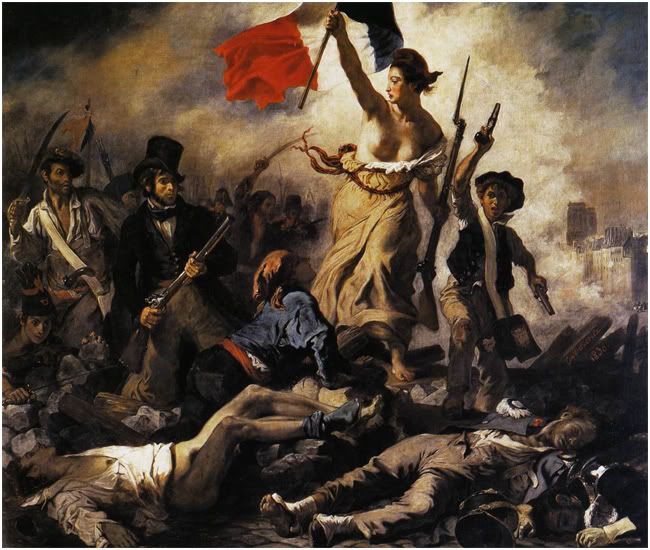
Liberty Leading the People by Eugene Delacroix (1830) The Louvre
It was painted in 1830, not long after the popular insurrection which inspired it. In the summer of that year Charles X, unloved Bourbon monarch of France, introduced several draconian measures to strengthen his increasingly frail grip on power. He abolished the freedom of the press and reorganised the electoral system to increase the power of the aristocracy. In Paris, the simmering discontent of the masses boiled over into outright violence. During “Three Glorious Days” at the end of July, an army of insurgents stormed and eventually took the Hotel de Ville. The King and his troops withdrew from the capital.
The people’s victory turned out to be a hollow triumph. The Duke of Orleans acceded to the vacant throne and was crowned Louis-Philippe, King of the French. Liberte, egalite and fraternite were not high on his list of priorities. As Delacroix cynically noted, the new king’s rule brought out placemen and parasites “just as a fall of rain brings out snails”. None of this could be guessed from his picture, a grand if slightly fantastical monument to a moment of revolutionary ardour. The work was purchased by the state and hurriedly put into cold storage, where it remained for decades. The dream of being led into a radiant future by a half-naked woman personifying Liberty was thought dangerous by the new regime. Those who had benefited from the insurrection did not wish to see it repeated.
It is unlikely that Delacroix meant to depict a specific incident. Partially obscured by gunsmoke, the west towers of Notre Dame appear in the background, the tricolor – rallying flag of the insurgents – fluttering distantly from one of them. Liberty brandishes the same standard, its colours subtly repeated in the clothing of the dead and wounded at her feet, as she leads the assault on the Hotel de Ville. Wearing the Phrygian cap associated with freedom, she hurdles a corpse-strewn barricade while urging on her comrades-in-arms. This revolutionary crowd was seemingly handpicked by the artist to reflect the broad social spectrum of the 1830 revolt. The men in berets and caps are artisans. The gun-toting urchin at Liberty’s side stands for the street children who joined in the fighting. The sombre top-hatted gentleman armed with a musket represents the radical wing of the bourgeoisie. He is a portrait of Etienne Arago, a zealous republican who ran the Theatre de Vaudeville (and is said to have raided its props cupboard for arms during the July uprising).
Allegory and actuality are inextricably intertwined in the picture, so it seems appropriate that the idea of placing an idealised female figure at the head of the revolutionary forces should have been inspired partly by fact and partly by fiction. According to the author of a pamphlet published anonymously in Paris in 1831, the painter drew on the legend of a laundry-girl who, wearing only her petticoat, went in search of her brother at the height of the uprising. On finding his naked corpse pierced by ten bullets she vowed to kill the same number of royal troops, but after having dispatched nine she was herself felled by a sabre-blow. Delacroix probably did mean to evoke this popular fable, judging by the way he has juxtaposed the near-naked corpse of a young man with the fallen bodies of members of the King’s Swiss guard. It seems that he was also influenced by some lines from a well-known poem about the revolt, by Auguste Barbier: “Liberty is not a countess / From the Faubourg Saint-Germain, / A woman who swoons away at the the slightest cry … She is a strong woman with thrusting breasts, / Who with her bronzed skin and her flashing eyes / Walks agile with great strides…”
Despite the rousing qualities of his painting, Delacroix was no radical egalitarian but a firm believer in social hierarchy. An admirer of Napoleon, under whom his older brother had risen to the rank of general, he harked back romantically to the days before Waterloo. For him, the tricolour held aloft by Liberty stood less for the spirit of 1789 than for glory and Empire. Alexandre Dumas, who met the painter on the streets of Paris at the height of the July uprising, noted that at first Delacroix was plainly terrified of the revolutionary mob. But when “this fanatic of the Empire” saw the tricolour, “the very standard of the Empire”, flying from Notre Dame, his fear suddenly gave way to passionate enthusiasm and Delacroix “started glorifying the same people who a moment ago had terrified him”.
Liberty Leading the People is an ambiguous work which has provoked much debate concerning Delacroix’s politics. But I think it would be wrong to interrogate it too closely as a political statement, because like many of the painter’s most compelling works what it actually expresses is not so much a point of view as a state of mind, a complex of thoughts and emotions. Delacroix wrote about his pictures in a way that suggests he thought of them as emanations of his own sensibility, and I suspect that what he really set out to create, with this unlikely but powerful mixture of allegory and realism, was a picture which somehow captured the heady blend of sensations and feelings – the sight of corpses, the smell of smoke, a rushing sense of idealism combined with a kind of coursing, sexual energy – which swept him along with the revolutionary crowd on that day in July 1830. He did not paint what he thought about social revolution, he painted what it felt like to be part of one.
Andrew Graham Dixon
13-07-2003
http://www.andrewgrahamdixon.com/

